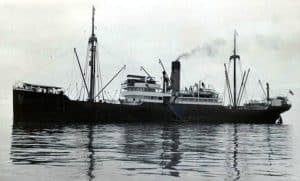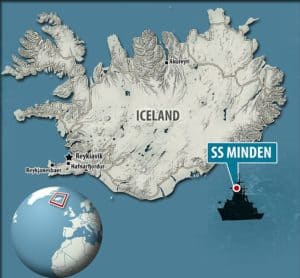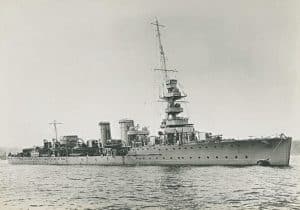 A group of British treasure hunters have found a chest that could contain up to £100million in Nazi gold in the wreck of a German cargo ship off the coast of Iceland.
A group of British treasure hunters have found a chest that could contain up to £100million in Nazi gold in the wreck of a German cargo ship off the coast of Iceland.
UK-based Advanced Marine Services found a box containing up to four tons of valuable metal, believed to be gold from South American banks, in the post room of the SS Minden, which sunk in 1939.
The gold was believed to be on board the ship and headed to Germany when the boat sank 120 miles southeast of Iceland on September 24, 1939, shortly after World War II began.

Advanced Marine Services has applied to the Icelandic government in hopes of gaining permission to cut a hole in the ship to remove the box.
The treasure hunters, who believe the haul belongs to the finder of the box, want to bring the contents back to Britain, according to The Sun.
Earlier this year, the group was accused of looking for the wreckage of the German cargo ship without proper licensing.
Authorities became aware of the firm after a stationary Norwegian research boat Seabed Constructor, rented by the firm, was spotted in Icelandic waters.
According to Iceland Monitor, when the coastguard asked the crew why they were there, they gave ‘vague and different explanations’, prompting the coastguard to instruct them to dock at a pier Reykjavik before sending in police to question the crew.
Georg Lárusson, director of the Icelandic Coastguard, told the website they did not have a permit to search in Icelandic waters.
He added: ‘The first answers we got were that they were looking at an ‘interesting target’ from the WW II, but couldn’t explain it any further.’
The SS Minden set sail from Brazil on September 6, 1939 after officials from Banco Germanico, a subsidiary of German Dresdner bank helped load the ship’s cargo.
When the ship was spotted by British cruisers HMS Calypso and HMS Dunedin, Adolf Hitler ordered Minden’s captain to scuttle – or deliberately sink – the ship so the Royal Navy wouldn’t seize the cargo.
The Minden crew was rescued by the HMS Dunedin and brought to Scapa Flow naval base in the Orkneys.
Historians have claimed records say the cargo on board was worthless, but due to how expensive it is to rent a research vessel, rumours are now circulating that the materials are valuable, with some saying that gold was on board.

For decades it has been believed that Nazi Germany transferred gold from overseas banks throughout World War II.
The loot was destined for a number of purposes: getaway money for high-ranking war criminals, the basis for a German resistance movement called ‘Werewolf’ intended to fight the occupiers; and to become the pension funds for generals whose vast estates bequeathed to them by a grateful Fuhrer in the east which fell into the hands of new, unforgiving owners.
The present whereabouts of Nazi gold since the end of World War II ended fuelled searches across Europe and the world as treasure hunters hope to win big with finds.
The world will never know just how much treasure the Nazis plundered – but it is believed to be a lot.
Much of it was stuffed on to trains headed for the Fatherland as the Reich began to crumble.
Just two thirds of the gold stolen by the Nazis from European central banks during the war has ever been found.
Just last month, Argentinian police said they believed they found the biggest collection of Nazi artifacts in the country’s history, including a bust relief of Adolf Hitler and magnifying glasses inside elegant boxes with swastikas.
Some 75 objects were found in a collector’s home in Beccar, a suburb north of Buenos Aires, and authorities say they suspect they are originals that belonged to high-ranking Nazis in Germany during World War II.
Another rumored gold haul was believed to be on a German train that disappeared.
Legend has it the locomotive set off from the western city of Wroclaw, Poland, (then known as Breslau) before mysteriously disappearing around Walbrzych (Waldenburg at the time) while fleeing the Red Army in 1945.
Fortune-hunters have looked for it for decades, and in the communist era the Polish army and security services even carried out apparently fruitless searches for it.
Local lore says Nazi Germany ordered the vast underground network, which snakes around the massive Ksiaz Castle, be built to hide Third Reich valuables.
German concentration camp inmates were used to build the huge tunnels – code-named Riese (Giant) – to use as production spaces for strategic weapons, as the site was safe from Allied air raids.
Located in the passages were underground Nazi shelters as well as one of Adolf Hitler’s headquarters.

